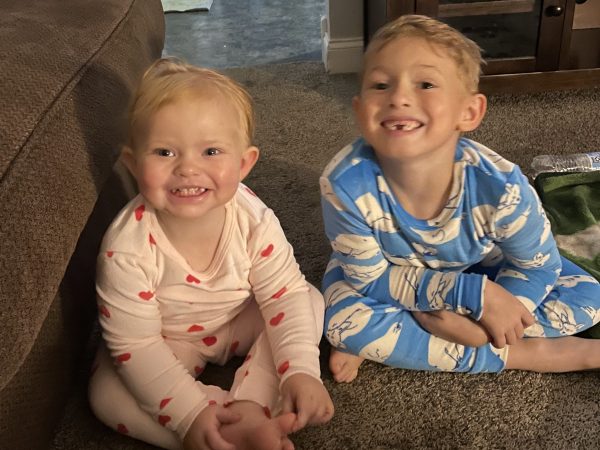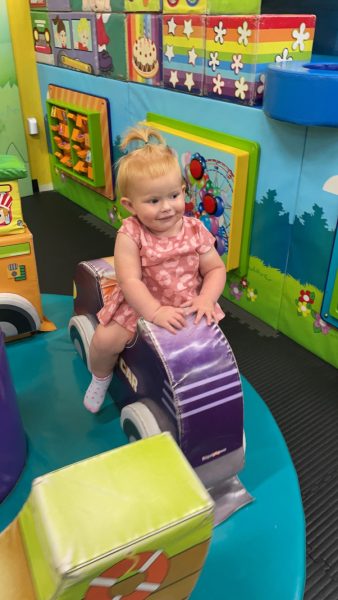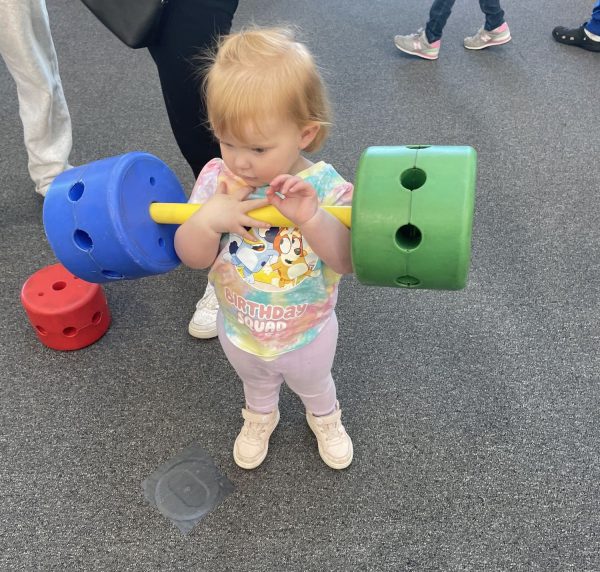
Two-year-old Lianora Layton, shown with her brother, experienced a brachial plexus birth injury, one of the most common birth injuries that affects about one to three in every 1,000 babies. Akron Children’s Brachial Plexus Treatment Center has helped her make remarkable progress to regain movement in her arm.
Kids who are diagnosed with a brachial plexus birth injury (BPBI) need access to treatment plans with specific assessments and interventions at different stages of their life. For families in the 25-county region that Akron Children’s serves, this specialized care is offered close to home through the Akron Children’s Brachial Plexus Treatment Center.
A brachial plexus birth injury is one of the most common birth injuries, affecting about one to three in every 1,000 babies. The brachial plexus is a network of nerves in the neck that controls movement and feeling in the shoulder, arm and hand. The injury can be minor or severe and can impair movement and sensation in the baby’s arm.
According to Stephanie Russo, MD, PhD, Akron Children’s pediatric hand and peripheral nerve surgeon and co-director of the Brachial Plexus Treatment Center, the biggest risk factor for a BPBI is shoulder dystocia where the shoulder gets stuck during delivery. Not all cases of shoulder dystocia cause an injury, however.
“The risk factors for shoulder dystocia include large birth weight (macrosomia), gestational diabetes, postterm pregnancy, difficult labor and prior shoulder dystocia in a previous child,” said Dr. Russo, who is one of the leading experts in brachial plexus birth injuries and a member of Plexus Nexus, a consortium that shares clinical and basic science expertise related to BPBI.
Treating a brachial plexus injury during infancy
Research shows that about 70 percent of children with brachial plexus birth injuries make a complete or nearly complete recovery within the first year, but that early intervention is critical. If children are to recover strength completely, they usually do so within the first three months.
“The Center’s specialized treatments help make sure no joint stiffness or other problems arise while the nerves are recovering,” Dr. Russo said. “About one-third of patients may need surgical intervention.”
Once a month, a team of Akron Children’s Brachial Plexus Treatment Center pediatric specialists gather to evaluate and treat children with brachial plexus injuries. The multidisciplinary team includes surgeons with expertise in orthopedic and peripheral nerve surgery, a physical medicine and rehabilitation doctor with expertise in brachial plexus injuries and other nerve conditions, occupational therapists experienced in treating brachial plexus injuries, and a social worker who can help coordinate care services. This clinical approach is designed to improve communications among the disciplines, as well as between the medical professionals and the family.

Lianora Layton started brachial plexus treatment as an infant. Early intervention helped her to build a rapport with her pediatric care team at Akron Children’s Brachial Plexus Treatment Center.
Ongoing treatment involves incremental steps
Two-year-old Lianora Layton of Wadsworth, Ohio, experienced a BPBI, causing her left arm to hang limp at her side. During her newborn checkup, Melissa Huang, MD, pediatrician at Akron Children’s Pediatrics, Wadsworth, referred Lianora to the Center.
At her first visit, Lianora was examined to assess the extent of her injury. The Center’s team recommended waiting to see if Lianora’s nerves healed on their own. Her parents, Nina Stein and Matthew Layton, were also taught different home exercises to do with Lianora to keep her joints mobile.
Over the next several months, Lianora’s team focused on helping her regain arm function and addressing issues as they came up. Lianora’s treatment and interventions included:
- Exercises for mobility
- A brace to position her arm and shoulder in an external rotation, which was worn 24/7 for a month
- Weekly physical therapy with the Center’s arm and hand therapists to prevent muscle tightness and maximize muscle strength
- Botox injections to temporarily weaken Lianora’s internal rotation. This was combined with a casting procedure to improve her shoulder’s external rotation.
A crawling mishap leads to reconstructive surgery
Lianora’s cast was removed around the time Lianora began crawling. Two days after its removal, Lianora bounced forward on her hands, which pushed her shoulders back and dislocated her left shoulder.
An MRI confirmed her main shoulder joint wasn’t in position, plus Lianora appeared to be in pain. Dr. Russo recommended she undergo a tendon transfer to help increase her arm movement and control. That surgery, performed shortly after Lianora’s accident, helped to allow for more external rotation.
Once again, Lianora’s arm was placed in a cast.

Physical therapy is helping Lianora Layton regain movement and strength in her left arm.
Making remarkable progress at Center close to home
More than one year after her surgery, Lianora has regained between 80 to 90 percent of the movement in her left arm, and her internal and external arm rotations have improved. Additionally, the 2-year-old attends occupational therapy sessions every other week with Akron Children’s Jaime Bass, a certified hand therapist.
“At first, Lianora didn’t like to go because of the treatments she had done to her arm when she was a baby,” Nina said. “But now she knows what is going to happen when she goes there.”
For Lianora and her parents, having a center close to home made getting her specialized treatment more convenient. Lianora also developed a rapport with her pediatric care team.
“It’s good that we were able to see Lianora as an infant,” Dr. Russo said. “She has made remarkable progress despite a few hurdles along the way. It’s not always a linear path to improvement, but our team is here for all the obstacles along the way.”
Akron Children’s Brachial Plexus Treatment Center is part of Akron Children’s Orthopedic department located in Akron. In addition, patients have the option to receive hand therapy closer to home at Akron Children’s health centers located in Boston Heights, Mansfield, Massillon and North Canton. For more information, visit Brachial Plexus Treatment Program.










